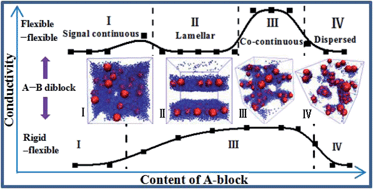Role of block copolymer morphology on particle percolation of polymer nanocomposites
Abstract
In this study, the effects of nanoparticle volume fraction, block stiffness, and diblock composition on the microstructure and electrical properties of composites are investigated using molecular dynamics simulation. It is shown that selective localization of conductive nanoparticles in a continuous block of diblock copolymer can dramatically reduce the percolation threshold. In the flexible–flexible copolymer systems with a relatively low particle loading, as the ratio of two blocks varies, one sees four kinds of phase structure: signal continuous, lamellar, co-continuous, and dispersed, corresponding to the order–disorder and continuity–dispersion transitions. In consideration of particle connectivity, the best electrical performance can be achieved with a special tri-continuous microstructure. While in the semi-flexible systems, the existence of rigid blocks can destroy the lamellar structure. If particles are located in the flexible block, a moderate stiffness of the rigid block can extensively enlarge the tri-continuous region, and high conductivity can be realized over a wide range of diblock compositions. If particles are located in the rigid block, however, high conductivity only emerges in a narrow composition range. In addition, the block should be prevented from becoming overstiff because this will cause direct particle aggregation.


 Please wait while we load your content...
Please wait while we load your content...